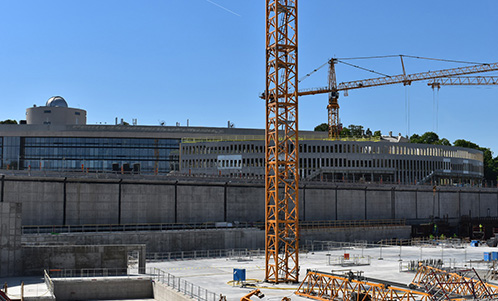The division is currently active within the following research fields. For additional information follow the links:
Concrete material properties
Properties related to material composition of reinforced and un-reinforced structures of concrete and other cement based materials are studied, with focus on efficiency and sustainability. State-of-the art laboratory methods are used together with advanced methods for numerical modelling and finite element analyses.
Read more about concrete material properties
Advanced concrete structures and design methods
Studies of static and dynamic modes of operation in concrete structures, that optimally fulfils demands on load carrying capacity, robustness and other functions. Large and advanced concrete structures subjected to extreme loads is studied through finite element modelling and in situ measurements.
Read more about advanced concrete structures and design methods
Concrete structures for the hydropower industry
Research on structures for the hydropower industry studies functions and optimizations of technical systems and concrete structures for a sustainable and environmentally friendly energy production. Advanced methods for in situ observations and measurements together with structural analysis are used.
Read more about concrete structures for the hydropower industry
Hydraulics, water and temperature action on hydraulic structures
The effect from flowing water, ice and temperature variations on concrete dams and hydraulic structures are studied. The large structures are studied through in situ measurements and observations and through numerical modelling. Hydraulic theories, computational fluid dynamic (CFD) simulations and multiphysical finite element models are used.
Read more about hydraulics and hydraulic structures
Civil engineering and maintenance of infrastructures
Research directed towards design, function and maintenance of concrete structures within civil engineering. Repair and strengthening of concrete structures are included. Special focus is on concrete roads and pavements but also bridges and other large structures are studied.
Read more about civil engineering and infrastructures
Shotcrete (sprayed concrete)
The performance and properties of shotcrete are studied in laboratory, in situ and through numerical modelling. The vibration resistance of young and hardened shotcrete on rock is one specialization.
Read more about shotcrete (sprayed concrete)
Protective concrete structures
Properties of concrete structures for e.g. shelters, barriers and energy absorbing systems are studied through numerical modelling and laboratory testing. Load cases of interest are explosions, air blasts, weapon loads, impacts and earthquakes.
Read more about protective concrete structures
Measurements and monitoring
The behaviour of concrete structures are studied in situ and in laboratory environment using measurement techniques, including photogrammetry and advanced sensors for measurement of displacements, temperatures, etc. Techniques for monitoring of structural behaviours in field environment are also developed.
Read more about measurements and monitoring
Construction, production and sustainability
Research directed towards studies on production, construction, design and function of infrastructure within civil engineering and buildings. Life cycle cost analysis methods are developed. Special focus is on methods for producing climate-smart and sustainable concrete structures.
Read more about construction and sustainability

